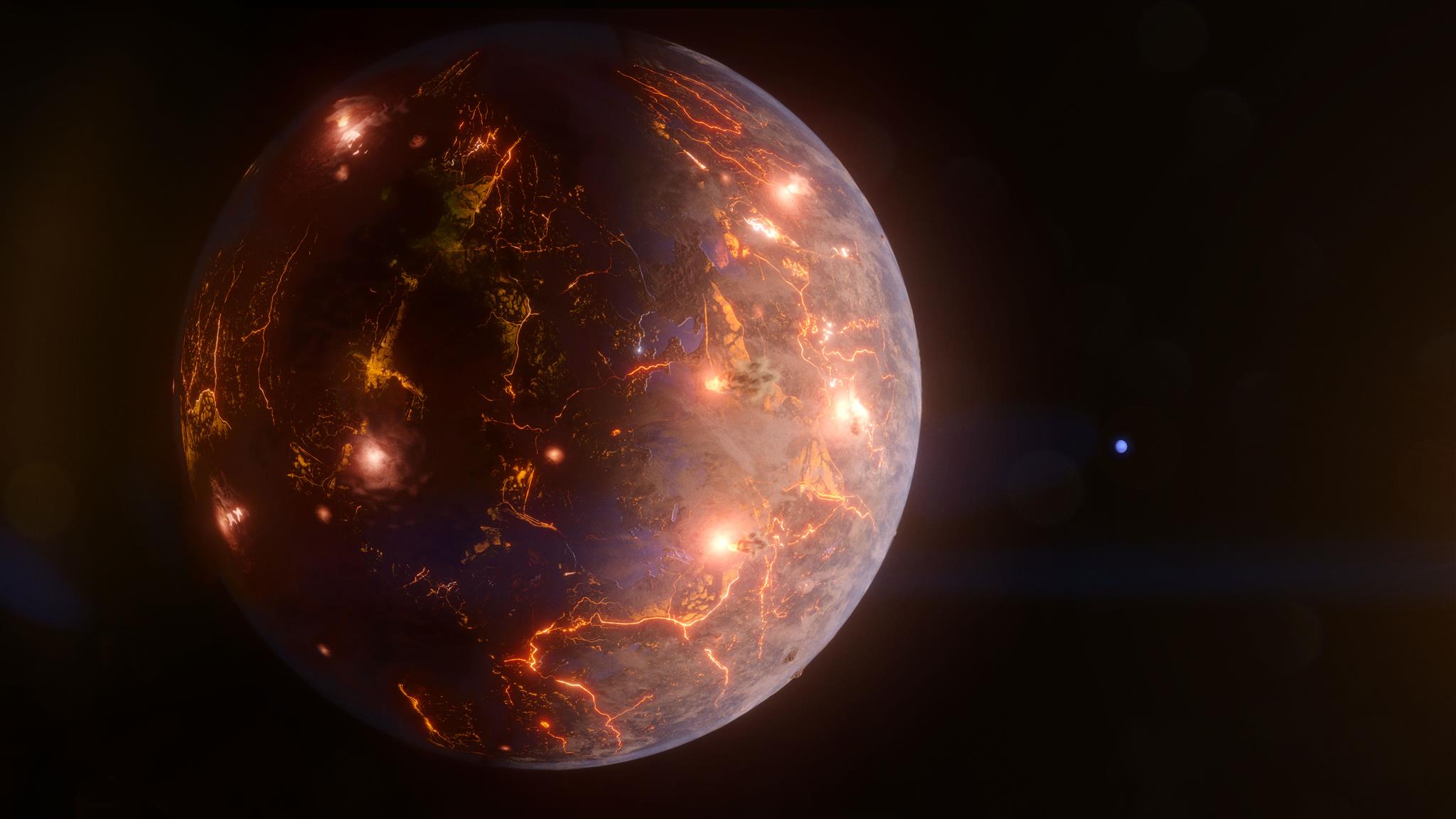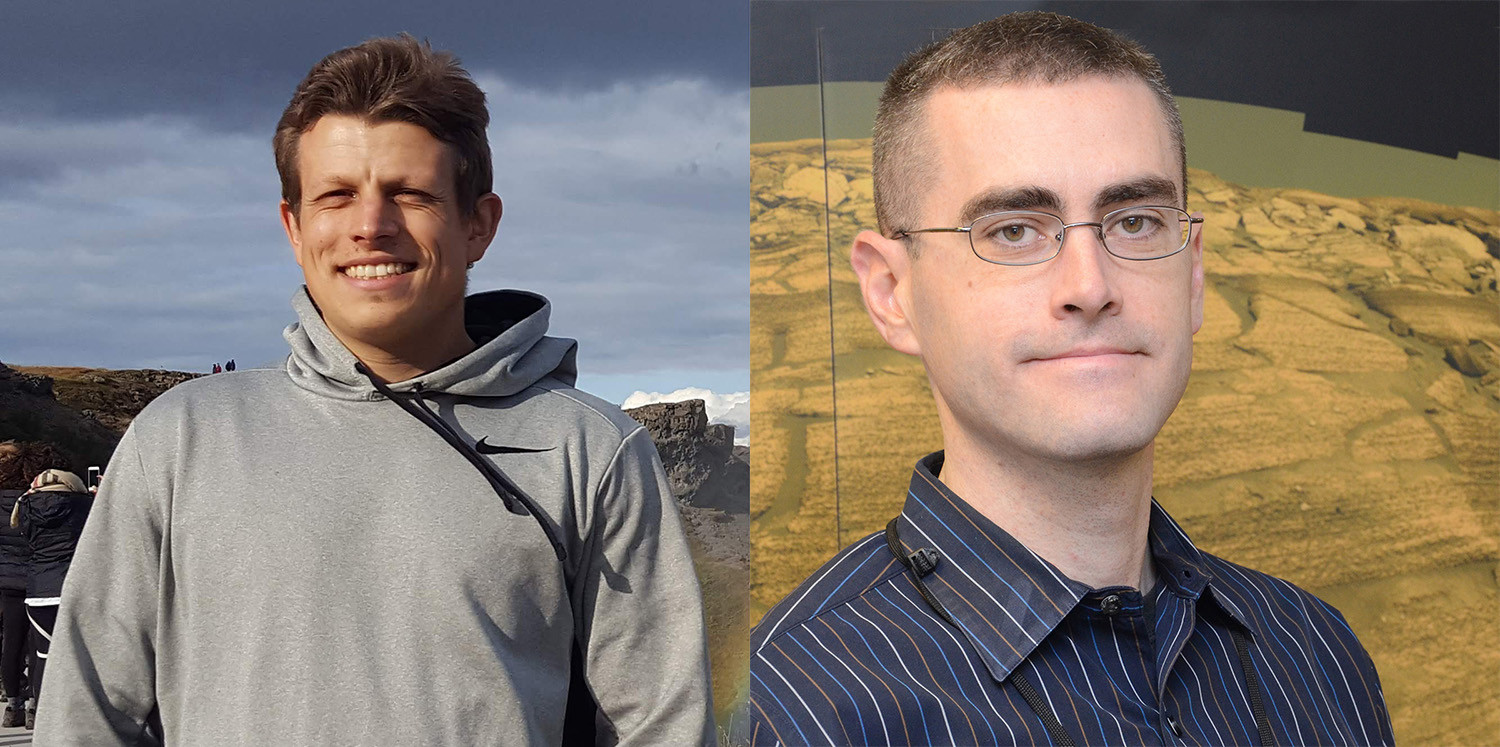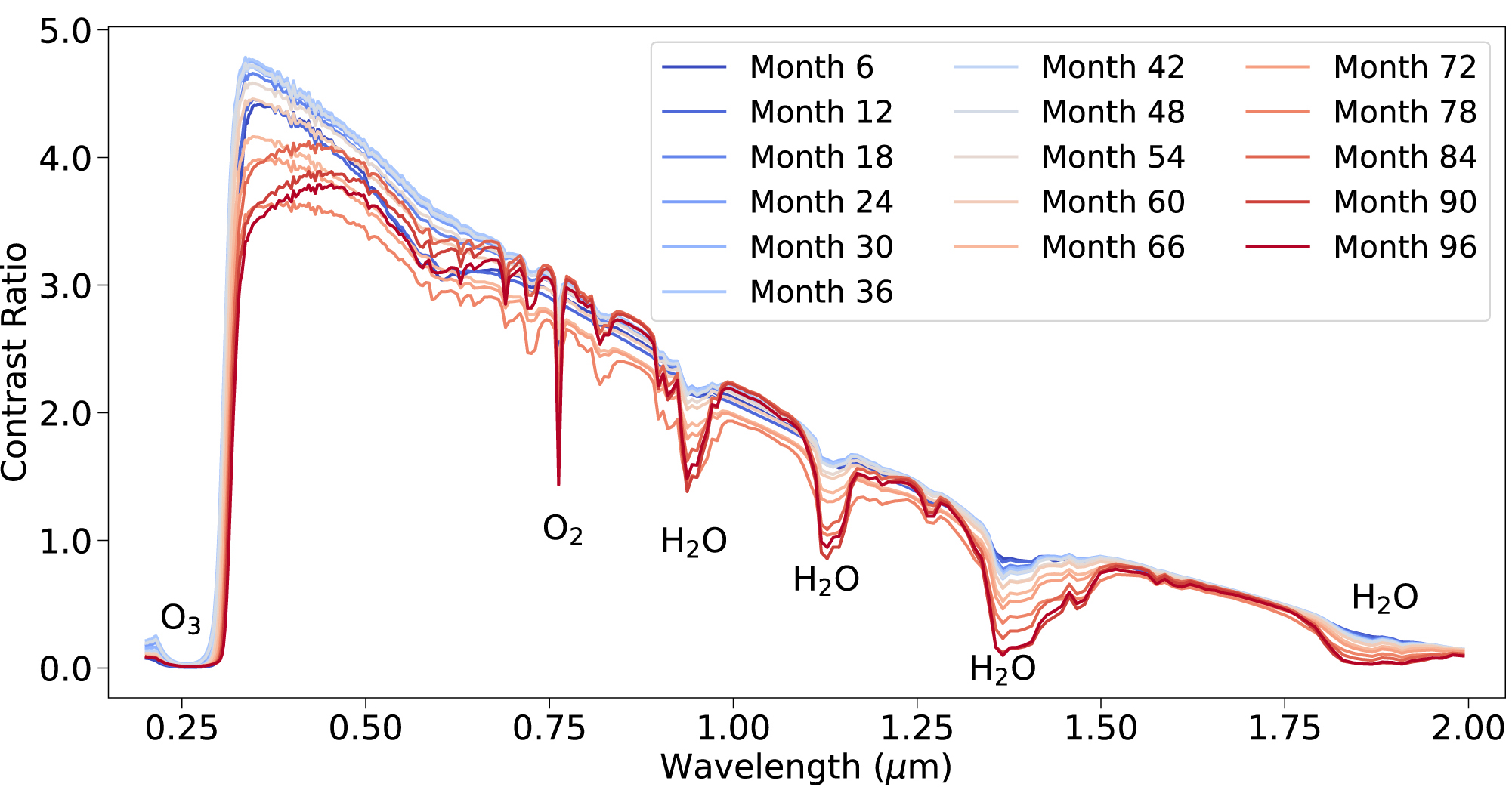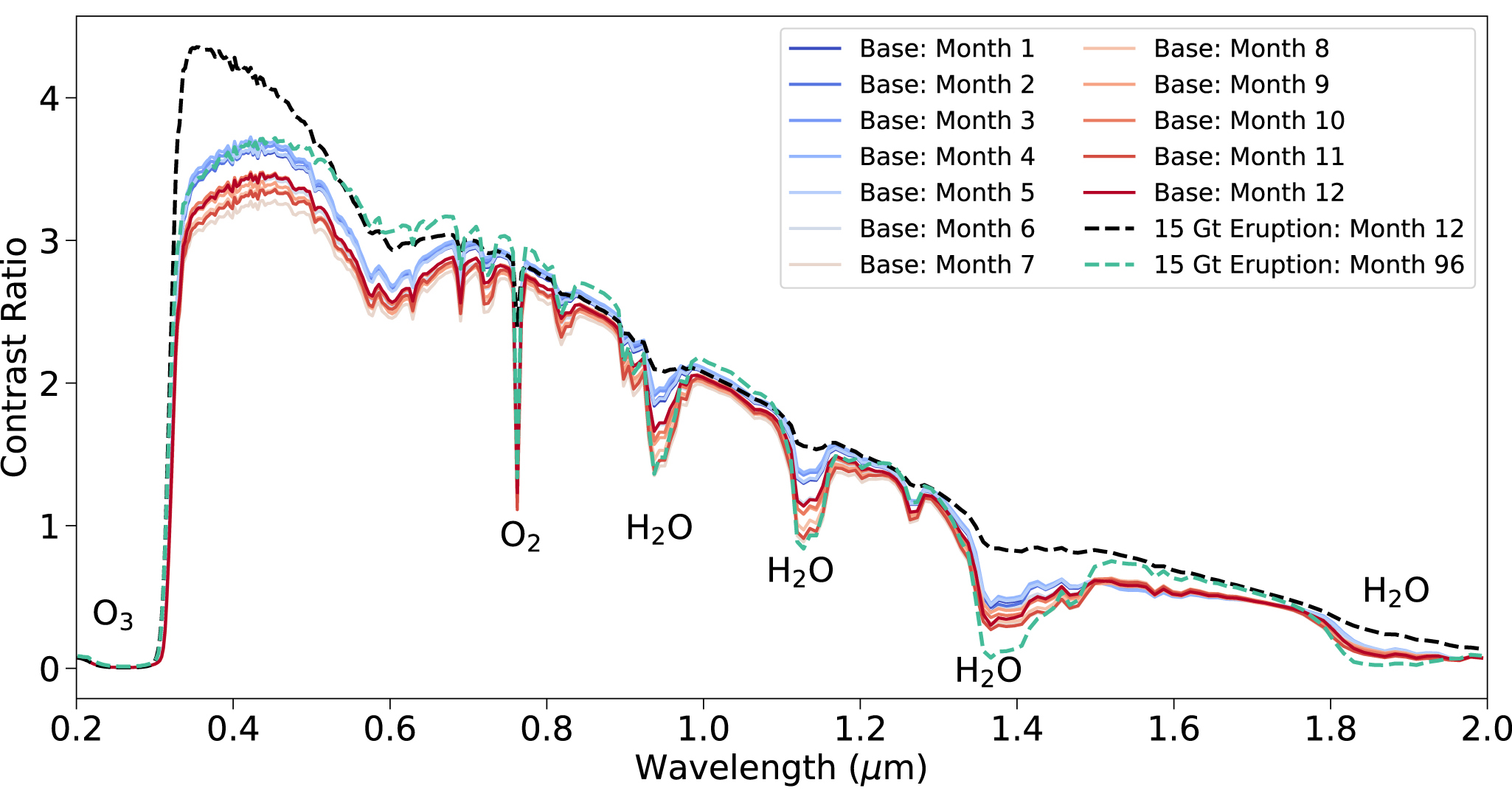NCCS-Hosted Simulations Enable Exploring
Prospects of Detecting Volcanic Signatures on ExoEarths

This artist's concept depicts LP 791-18 d, an Earth-size world about 90 light-years away discovered using data from NASA’s Spitzer Space Telescope and Transiting Exoplanet Survey Satellite (TESS) along with many other observatories. The gravitational tug from a more massive planet in the planetary system, shown as a small blue disk in the background, may result in internal heating and volcanic eruptions — as much as Jupiter’s moon Io, the most geologically active body in our solar system. Illustration by NASA’s Goddard Space Flight Center/Chris Smith (KBRwyle).
The NASA Center for Climate Simulation (NCCS) enabled University of California (UC), Riverside, and NASA Goddard Space Flight Center scientists to simulate how large igneous province volcanic eruptions — some of the most massive in Earth’s history — affect the planet’s climate and atmospheric chemistry. The simulation data then served to define the atmosphere of a hypothetical rocky Earth-like exoplanet (or exoEarth) for exploring the possibility of detecting volcanic signatures with future space telescopes.
“We chose this study because there have been few works that investigated direct imaging a volcanic exoEarth,” said study co-lead Colby Ostberg, a Ph.D. student in Geological Sciences at UC Riverside and NASA graduate student intern (at the time of the study). “Coupling my knowledge of exoplanet spectroscopy with Dr. Guzewich’s expertise in Earth climate models was necessary for us to properly model the climate and observations of a hypothetical exoEarth.”
Study co-lead Scott Guzewich is Associate Lab Chief of NASA Goddard’s Planetary Environments Laboratory. Their interdisciplinary study appears in The Astronomical Journal.

Left to right: Colby Ostberg, University of California, Riverside, and Scott Guzewich, NASA Goddard Space Flight Center, served as co-leads on the exoEarth study.
The team simulated four exoEarths over 8 years with ongoing large igneous province eruptions with outputs ranging from 1.8 to 60 gigatons of sulfur dioxide. A fifth baseline case released no sulfur dioxide. The largest case produces similar amounts of sulfur dioxide as the colossal eruptions of the Tambora volcano in 1815 and the Toba volcano 74,000 years ago, both of which had global effects. By comparison, the estimated yearly release of sulfur dioxide from all of Earth’s volcanos is a mere 0.01 gigatons.
The five 8-year simulations used the Goddard Earth Observing System Chemistry-Climate Model (GEOSCCM) with 1-by-1-degree (~111-kilometer) horizontal resolution in both the ocean and the atmosphere. The simulations ran on the NCCS Discover supercomputer, employing roughly 700 processors in parallel. Each simulation took approximately 1.5 months of wall-clock time.
“Completing these volcanic eruption chemistry-climate model simulations would not be possible without NCCS supercomputing resources,” Ostberg said. “Attempting such simulations on smaller computer clusters would be prohibitive in wall-clock time.”
Data analysis using NASA Goddard’s Planetary Spectrum Generator (PSG) considered simulated water vapor, carbon dioxide, ozone, nitrous oxide, sulfur dioxide, methane, oxygen, nitrogen, volcanic aerosol, water aerosol, and water ice — as might be observed by a future space telescope.

The reflectance spectrum of a 30-gigaton (Gt) exoEarth volcanic eruption for every 6 months of the simulation in linear scale. Spectra are shown for ozone (O3), oxygen (O2), and water (H2O) in units of contrast ratio, which is the radiance of the planet divided by the radiance of the star it orbits. There is variation in the size of the O3 absorption feature and in the slope of the spectra between 0.3 and 0.6 micrometers (µm) due to fluctuations in volcanic aerosol abundance throughout the simulation. Figure adapted from Ostberg et al., 2023.
“Our study demonstrated that fluctuations in the perceived amount of ozone and water in the atmosphere of an exoEarth could be indicators of ongoing volcanism,” Ostberg said. “Observing sulfur dioxide in an Earth-like atmosphere is a strong sign of ongoing volcanism, and we were surprised that all signs of sulfur dioxide in the exoEarth reflectance spectrum were concealed despite the massive eruptions that we modelled.”
These findings have implications for interpreting observations from future NASA space telescopes such as the Habitable Worlds Observatory (HWO) and LUVOIR-B. Ostberg explained that the results showed how HWO might constrain the chemical composition of an exoEarth atmosphere and illustrated how volcanism affects an exoEarth reflectance spectrum (a graph tracing the amount of light being reflected from atmospheric chemicals at specific wavelengths). In addition, study co-authors Ravi Kopparapu and Thomas Fauchez at NASA Goddard and Stephen Kane at UC Riverside are all involved in HWO planning, and Ostberg plans to continue doing HWO preliminary studies after finishing his doctorate.

The reflectance spectra of oxygen (O2) and water (H2O) for each month of the baseline exoEarth simulation in comparison to months 12 and 96 of the 15 Gt eruption in linear scale. Figure adapted from Ostberg et al., 2023.
In a follow-on study using the NCCS Discover supercomputer, Guzewich and collaborators continued analyzing the GEOSCCM simulations and extended them to 25 years duration. Their focus was on how the eruptions could warm Earth’s climate through an increase in stratospheric water vapor. That research was published this summer in the Journal of Geophysical Research: Atmospheres.
RELATED LINKS
- Ostberg, C.M., S.D. Guzewich, S.R. Kane, E. Kohler, L.D. Oman, T.J. Fauchez, R.K. Kopparapu, J. Richardson, and P. Whelley, 2023: The Prospect of Detecting Volcanic Signatures on an ExoEarth Using Direct Imaging. The Astronomical Journal, 166, no 5, 199, doi:10.3847/1538-3881/acfe12.
- Guzewich, S.D., L.D. Oman, P.R. Colarco, J.A. Richardson, P.L. Whelley, T.J. Fauchez, R.K. Kopparapu, and S.T. Bastelberger, 2024: A Potential Surface Warming Regime for Volcanic Super-Eruptions Through Stratospheric Water Vapor Increases. Journal of Geophysical Research: Atmospheres, 129, e2023JD038667, doi:10.1029/2023JD038667.
- “NASA’s Spitzer, TESS Find Potentially Volcano-Covered Earth-Size World,” NASA Web Feature, May 12, 2023.
Jarrett Cohen, NASA Goddard Space Flight Center
September 26, 2024


